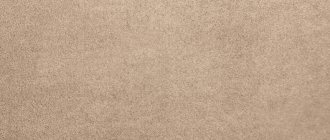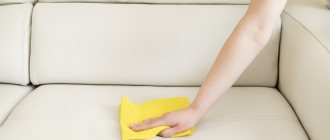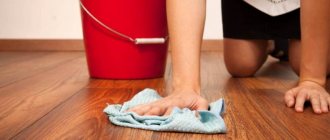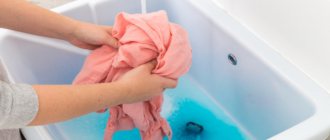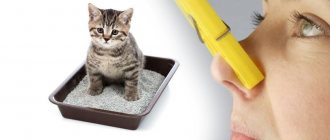How to remove urine stains from sofa upholstery?
One of the most persistent and unpleasant stains is urine stains. This happens especially often in families with small children and elderly people who have poor control over urination. In addition to the fact that such stains deplete the unpleasant odor, they also greatly damage the sofa.
Instructions:
- In order to get rid of this kind of contamination, it is necessary, immediately after the child has peed, to place terry towels or paper napkins on the sofa and blot until the fabric becomes dry.
- It is necessary to completely soak up the remaining urine so that it does not penetrate deeply into the upholstery of the sofa. Now you need to soak a new kitchen sponge in water, lather it with laundry soap, and thoroughly rub the stains.
- It is necessary to lather and remove the foam several times to be absolutely sure that there is no trace of urine left there. After such manipulation, it is necessary to moisten a damp cloth and remove any remaining foam; this must be done several times.
- To completely remove the smell of urine, you need to dissolve 3 tablespoons of vinegar in 5 liters of warm water, soak a brush in the solution and apply the solution to the areas that have just been cleaned of urine.
- Next, you need to rub, after which you need to blot the area several times with a napkin or towel. It is necessary to dry quickly; for this you can use a hair dryer or iron. Never iron the upholstery with direct contact between the fabric and the iron.
- Cover the damp sofa with thin film or gauze. Do not allow the sofa to dry on its own, without using heating devices. It is long drying that contributes to the formation of streaks.
Cleaning the sofa
Stain on fabric
Water stains that appear on clothes cause no less trouble.
Removing stains from drape.
If a rainwater stain appears on the drape, you need to dry the clothes and clean the stain with a thick, stiff brush. Afterwards, you need to shake the product thoroughly and thoroughly steam it through a soft linen cloth soaked in a weak solution of vinegar (1 teaspoon 1 liter of water).
After boiling the coat (or other clothes made from drape), hang it on hangers, but do not put it in the wardrobe, let it cool and dry at room temperature, then it will not lose its shine and presentation.
Removing stains from silk.
On silk fabrics, water leaves unsightly grayish-white stains. They are removed as follows: wipe with a soft linen cloth soaked in strongly salted water (1 teaspoon per 1 glass of water at room temperature). Allow the stain to dry, then use a soft, dry linen cloth to remove the white coating along with traces of water stains.
Removing stains from cotton and linen.
Water leaves nasty yellow marks on cotton and linen fabrics that are very difficult to remove. Remember: bleaches that contain chlorine are not suitable for such materials, because it will thin their surface and give them a dirty yellow tint.
How to get rid of stains on a tablecloth
For this reason, experienced housewives specially make bleach for cotton and linen fabrics from scrap materials - salt and lemon.
The technology for removing stains is as follows: first you need to moisten the contaminated area and squeeze it out thoroughly, then place it with the stain facing up on a layer of cotton wool or napkins. Then cover with a thick layer of coarse table salt. Pour freshly squeezed lemon juice over the salt. Use a toothbrush to rub the mixture into the fabric and let it sit on the stain for at least two hours.
After this, use a brush to thoroughly brush off the dried salt from the stain and wash the product.
Our grandmothers removed yellow stains from linen and bleached other fabrics this way: on the eve of Epiphany, they buried these fabrics in the snow. On January 19 (Epiphany Day) they rinsed it in an ice hole and dried it in the cold. They say that the blouses and undershirts of Russian peasants were always immaculately white.
Removing stains from suede and leather.
The biggest problem is removing water stains and stains from the surface of leather and suede products.
Usually the skin is treated with a light application of soap solutions mixed with ammonia. After this treatment, the surface is slightly dried and rubbed with glycerin or petroleum jelly.
White skin is cleaned with tooth powder, or a mixture of milk with egg white whipped into a tight foam.
Whitish water stains can be removed from suede and leather shoes as follows: sprinkle a thick layer of salt on a damp surface, let it soak in moisture and leave under this crust for two days at room temperature. Then shake off the salt, wipe the shoes with turpentine and polish with velvet cloth.
You can remove stains from gloves like this: put them on your hands and wash them with mild liquid soap. Then, without rinsing, dry your gloved hands with a towel. Dry the gloves on your hands, then remove them, stretch them out, wrap them in a dry white terry towel, and place them under a stack of heavy books for a couple of days.
If the gloves are very dirty, you need to quickly (within two to three minutes) rinse them with clean aviation gasoline. Afterwards, without rinsing, wipe them dry with a soft linen cloth.
How to deal with wax stains on clothes: rules for removing greasy paraffin stains
Often stains on suede remain after ironing. Remember: suede is always ironed from the wrong side through dry fabric made of natural silk. The heat of the iron should be set to the minimum temperature. After ironing, the surface of the suede must be cleaned and “invigorated” with a special rubber brush, which has two surfaces: one with sparse teeth, the other with fine teeth. First, they are treated with a sparse brush, then with a frequent one. After such care, suede clothing will always look perfect.
How to remove water stains from sofa upholstery?
Instructions:
- To finally get rid of the smell of urine and traces of water, you need to prepare a special solution. It will help remove residual urine, so it will help stains disappear. It is necessary to mix 100 milliliters of water with a teaspoon of soda in a small bowl and shake.
- After this, you need to measure out 100 ml of hydrogen peroxide, which can be purchased at a pharmacy and pour into the container. It is necessary to pour the solution into a spray bottle and apply it to the dried sofa after using vinegar.
- As a result of exposure, a lush foam is formed, which will help remove residual urine and stains. It is necessary to leave the foam on the sofa for several hours, and then remove it with a damp cloth. It is worth drying the upholstery again using heating devices, an iron or a hairdryer.
Stains after cleaning the sofa
Glass in the doors
When planning to clean the door structure, it is important to consider that leaves and frames made of PVC, chipboard and plywood require careful handling. Materials are damaged by abrasive due to the sensitive surface.
It is advisable to prevent water from getting on the laminated MDF if there is no PVC edge. The material may delaminate. The coating will deteriorate from oils, acids, alkalis, alcohol and acetone.
Classic glass inserts are cleaned with window cleaner, and frosted glass with soft microfiber cloths.
Important! It is prohibited to clean frosted glass with fluorine-containing compounds. The element breaks the structure of the glass.
How to remove stains from sofa upholstery after cleaning upholstered furniture?
Stains appear for one simple reason: the sofa dries out and gets wet unevenly. Therefore, try to carry out not only partial cleaning, but also complete cleansing. It will not be possible to wash the stain separately, because its edges will remain. After drying, you will notice that streaks have formed.
To prevent this from happening, you need to apply cleaning products to the entire sofa. To avoid streaks after cleaning, many experts recommend vacuuming upholstered furniture once a week with a regular vacuum cleaner using dry cleaning. Once every three months you need to knock out the sofa.
To prepare upholstered furniture for stain removal, you must perform the following manipulations:
- Dilute a glass of vinegar and 4 tablespoons of soda in 5 liters of water, stir the mixture
- Soak an unwanted sheet or white cloth in it. Gently wring it out so that it is not wet, but slightly damp.
- Cover the upholstered furniture and gently beat it with a beater. Do not hit as hard as you can, so as not to damage the upholstery and filling of upholstered furniture.
- Thanks to such manipulations, all the dust will transfer to the fabric. This will make it dirty and dusty. You will need to rinse the fabric several times during the beating process.
- Thanks to this action, you will be able to transfer the dust to the fabric, and the sofa will become cleaner and there will be no streaks left after washing.
Cleaning the sofa
Stains on the wall
Yellowish-gray stains on the walls and ceiling can destroy any interior, no matter how much it costs, so at the first sign of a flood, immediately begin to eliminate it.
First, eliminate the source of uncontrolled water flow. Then take a number of measures to prevent this from happening again, in other words, have a preventative conversation with your neighbors (if the reason lies in their carelessness) or repair the roof (if you live in a private house and did not take care of a good roof in a timely manner). Then you can start removing stains.
This process will take place in three stages:
- removing damaged layers of finish;
- restoration of plaster and primer;
- carrying out finishing work.
Repair with removal of damaged layers.
If the stain has already dried, then moisten it with a sponge and remove the wallpaper, whitewash or paint, as well as the layer of plaster up to the wall with a spatula.
You should not leave wet and dried plaster, because a yellow spot - evidence of wetness - will appear through any layers, again and again reminding you of the stress caused by flooding.
Removing handle stains from leatherette and leather products
Then give the wall a coat of plaster, dry it and prime it. After these coatings have completely dried, finishing can be done - painting or wallpapering.
Whitening stains.
If you are doing this repair yourself, and the stain was not too bad, then you can get by with bleaching the stain. To do this, wash the paint or whitewash (or remove the wallpaper) on the damaged area, wash the plaster, and lightly dry this area. Dilute a bleach containing bleach (for example, “Whiteness” or “Duckling” with a rust removal function) in water and rinse the stain. Dry. If the yellow stain remains, repeat the surface treatment.
Then you need to apply a primer and perform finishing work (paint, whitewash or wallpaper).
How to remove stains from sofa upholstery using cleaning products?
Instructions:
- If after such manipulation you see that the stains have not gone away, you need to clean it. To do this, take Vanish and dilute it according to the instructions. Choose a carpet and upholstery cleaner. Fill a spray bottle with liquid and spray the stains.
- Under no circumstances should you rub. In this case, it is necessary to apply the product not only to the stains, but completely to the entire sofa. Try to ensure that the product evenly covers all upholstered furniture. Next, you need to place a dry cloth on top and dry absolutely all places.
- Never scrub using a brush or sponge. Next, after the upholstered furniture has completely dried, you need to take a vacuum cleaner and dry clean it. As a result of such manipulations, stains usually disappear completely.
- To speed up the drying process and reduce the risk of streaks, you can use a hairdryer or iron when drying upholstered furniture.
Clean sofa
Use of special means
If folk and improvised means do not give the desired result, you need to switch to “heavy artillery”.
Wet cleaning is very effective.
Purchase special products - stain removers for carpets and home textiles. The main thing is to use a special product suitable for your furniture (for example, suede, microcorduroy, velor, plush, etc.).
Vanish is an excellent cleaner not only for stains, but also for unpleasant odors.
There are also universal stain removers on sale, for example, Vanish or Sano. The Karcher brand offers a large selection of auxiliary cleaning products.
You need to use special household chemicals according to the instructions. If the manufacturer indicates on the label the proportions or dosage for dilution, do not violate the instructions. Otherwise, you may damage the upholstered furniture or not achieve the desired result.
Now you know how easy it is to remove whitish stains from your sofa after cleaning. But in fact, it’s easier to prevent their appearance - just thoroughly vacuum the surfaces before wet cleaning and do not wet the upholstery with large amounts of water.
Relax after cleaning your couch!
How to remove stains from the upholstery of a Vanish sofa?
You can deal with stains using a steamer. It is advisable for them to clean them once a month. Many people recommend using a car interior cleaner to get rid of stains. Indeed, such products are good at getting rid of stains and dirt. In addition, they do not leave behind stains.
Instructions:
- Buy any product at a car dealership. Doesn't have to be the most expensive, and stick to the instructions. The ideal option would be wet cleaning with a vacuum cleaner. Pour the product into the liquid supply reservoir, connect the tube to the telescopic pipe and spray evenly onto the sofa.
- After this, you need to vacuum in the usual way. If necessary, it is worth cleaning several times. After final cleaning, dry the sofa using a hairdryer or iron to help it dry faster.
- If there are any rough spots or rough spots left, after the sofa has completely dried, dry clean it using a vacuum cleaner or a regular carpet brush.
Removing stains after cleaning the sofa
Stains on the sofa appear due to the fault of the owner herself, who does not properly clean the stains. Under no circumstances should you partially wash out stains. This must be done over the entire area of upholstered furniture, applying the cleaning agent evenly.
Universal special products for removing whitewash from the floor
You can remove whitewash from the floor covering using special household chemicals. The most optimal are:
- Frost. The product contains biodegradable surfactants. They are made on a plant basis. They are harmless because they are found in limited quantities in the detergent;
- "Mister proper". Floor cleaning liquid. It is distinguished by the presence of pleasant aromas that can be chosen at will. The composition contains components that can remove stains even during the first wash of the floor;
- "Mister Muscle". Another branded product that does an excellent job of cleaning floor coverings from most types of dirt, including lime. Suitable for varnished, polished and matt surfaces. Does not require repeated washing with clean water and wiping dry.
Please note that all listed formulation options have individual instructions for use; be sure to study them and follow the dosage. If this is not followed, there is a high risk of damage to the floor.
Professional floor cleaner Source zavhoz-spb.ru
Rules for washing different types of glass
To avoid mistakes in finding the ideal glass surface cleaner, you should exclude:
- mixing ammonia with chlorine-containing compounds;
- use of ammonia;
- the use of soda and other abrasives.
Among the most popular types of glass in facade design, materials with coatings are often used: self-cleaning, low-emission, smart glass. The listed products require careful handling, since the film on the surface, if damaged, loses its characteristics and no longer provides the specified functionality.
When caring for frosted glass, it is advisable to use special spray products. To remove heavy dirt, you can try rubbing it with a cloth soaked in ammonia. Less caustic substances - vinegar, chalk solution.
Tip: to make frosted glass look beautiful, it is regularly wiped with suede or other fabric with lint.
Tinted glass with film is very sensitive to abrasives, acids and alkalis. It is worth familiarizing yourself with the manufacturers' recommendations for caring for glass products in order to choose the right product without causing damage.
